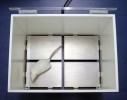Authors
A. Pujol, C. Hindelang, N. Callizot, U. Bartsch, M. Schachner et al.
Lab
Institut de Génétique et de Biologie Moléculaire et Cellulaire, CNRS/INSERM/ULP, ILLKIRCH, France ; Societé Neurofit, ILLKIRCH, France ; Zentrum für Molekulare Neurobiologie, Hamburg, Germany.
Journal
Human Molecular Genetics
Abstract
Adrenomyeloneuropathy (AMN) and cerebral childhood adrenoleukodystrophy (CCALD) are the main phenotypic variants of an X-linked inherited metabolic disorder causing demyelination, X-linked adrenoleukodystrophy (X-ALD). It is caused by mutations in the ABCD1 (ALD) gene encoding a peroxisomal ABC transporter. Inactivation of the murine ALD gene does not lead to a detectable clinical phenotype in mice up to 6 months, and no cerebral pathology resembling the childhood form (CCALD) was observed. In this work, we show that older ALD-deficient mice exhibit an abnormal neurological and behavioral phenotype, starting at around 15 months. This is correlated with slower nerve conduction, and with myelin and axonal anomalies detectable in the spinal cord and sciatic nerve, but not in brain. The phenotype of ALD-deficient mice mimics features of human AMN, thus providing a model for investigating the pathogenesis of this disease.
BIOSEB Instruments Used:
Aron Test or Four Plates Test (LE830),Rotarod (BX-ROD)

 Pain - Thermal Allodynia / Hyperalgesia
Pain - Thermal Allodynia / Hyperalgesia Pain - Spontaneous Pain - Postural Deficit
Pain - Spontaneous Pain - Postural Deficit Pain - Mechanical Allodynia / Hyperalgesia
Pain - Mechanical Allodynia / Hyperalgesia Learning/Memory - Attention - Addiction
Learning/Memory - Attention - Addiction Physiology & Respiratory Research
Physiology & Respiratory Research
 Pain
Pain Metabolism
Metabolism Motor control
Motor control Neurodegeneration
Neurodegeneration Cross-disciplinary subjects
Cross-disciplinary subjects Muscular system
Muscular system General activity
General activity Mood Disorders
Mood Disorders Other disorders
Other disorders Joints
Joints Central Nervous System (CNS)
Central Nervous System (CNS) Sensory system
Sensory system

